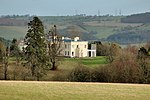Llangattock-Vibon-Avel
Former communities in MonmouthshireVillages in Monmouthshire

Llangattock-Vibon-Avel (Welsh: Llangatwg Feibion Afel) is a rural parish and former community, now in the community of Whitecastle in Monmouthshire, south-east Wales, in the United Kingdom. It is located 5 miles (8.0 km) west of Monmouth and some 13 miles (21 km) east of Abergavenny, just off the B4233 old road between the two. Villages within the former community include Llangattock itself, Skenfrith, Rockfield, and Newcastle.
Excerpt from the Wikipedia article Llangattock-Vibon-Avel (License: CC BY-SA 3.0, Authors, Images).Llangattock-Vibon-Avel
Whitehill Lane,
Geographical coordinates (GPS) Address Nearby Places Show on map
Geographical coordinates (GPS)
| Latitude | Longitude |
|---|---|
| N 51.83726 ° | E -2.78804 ° |
Address
Whitehill Lane
NP25 5NH , Whitecastle
Wales, United Kingdom
Open on Google Maps











